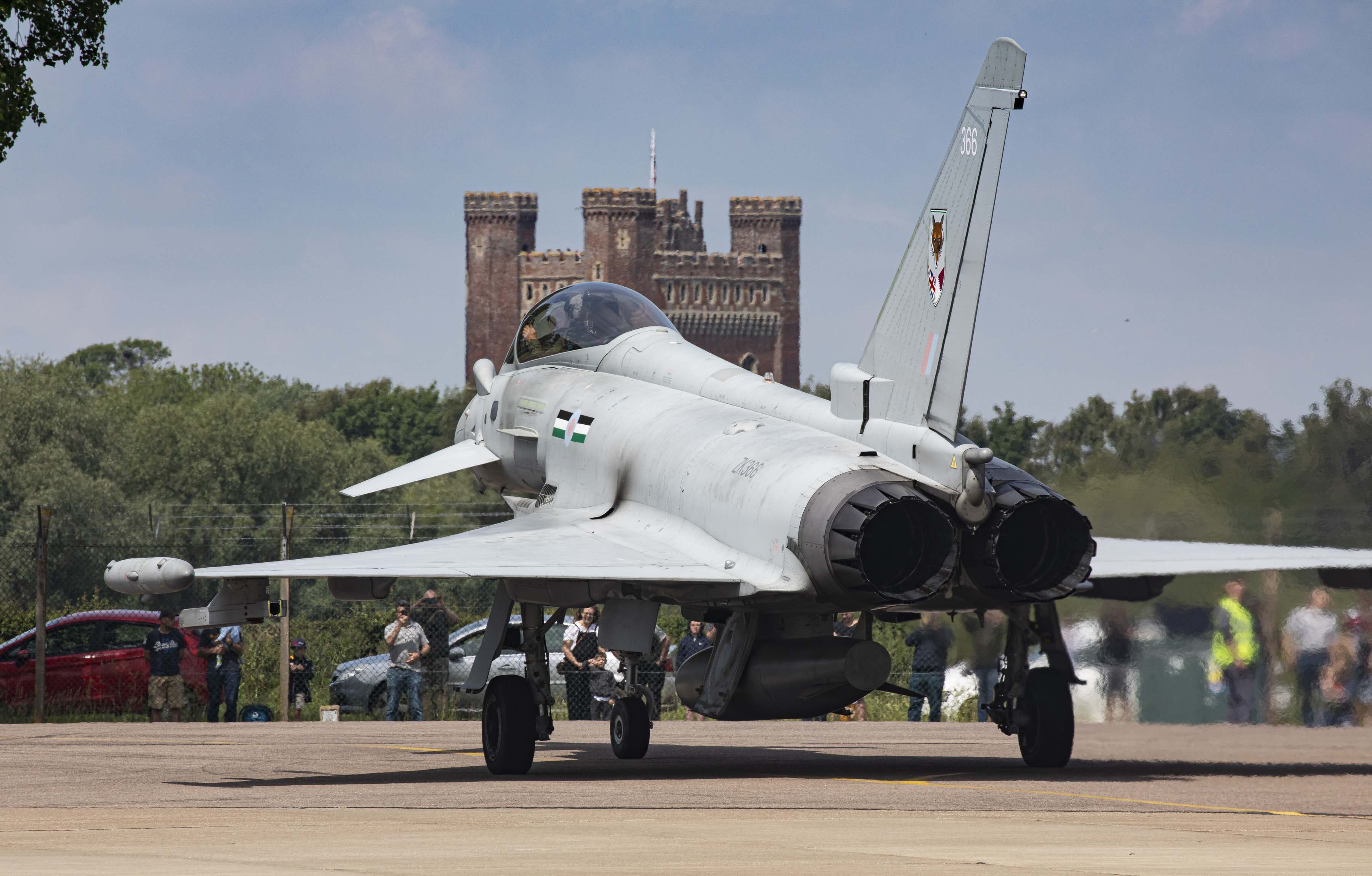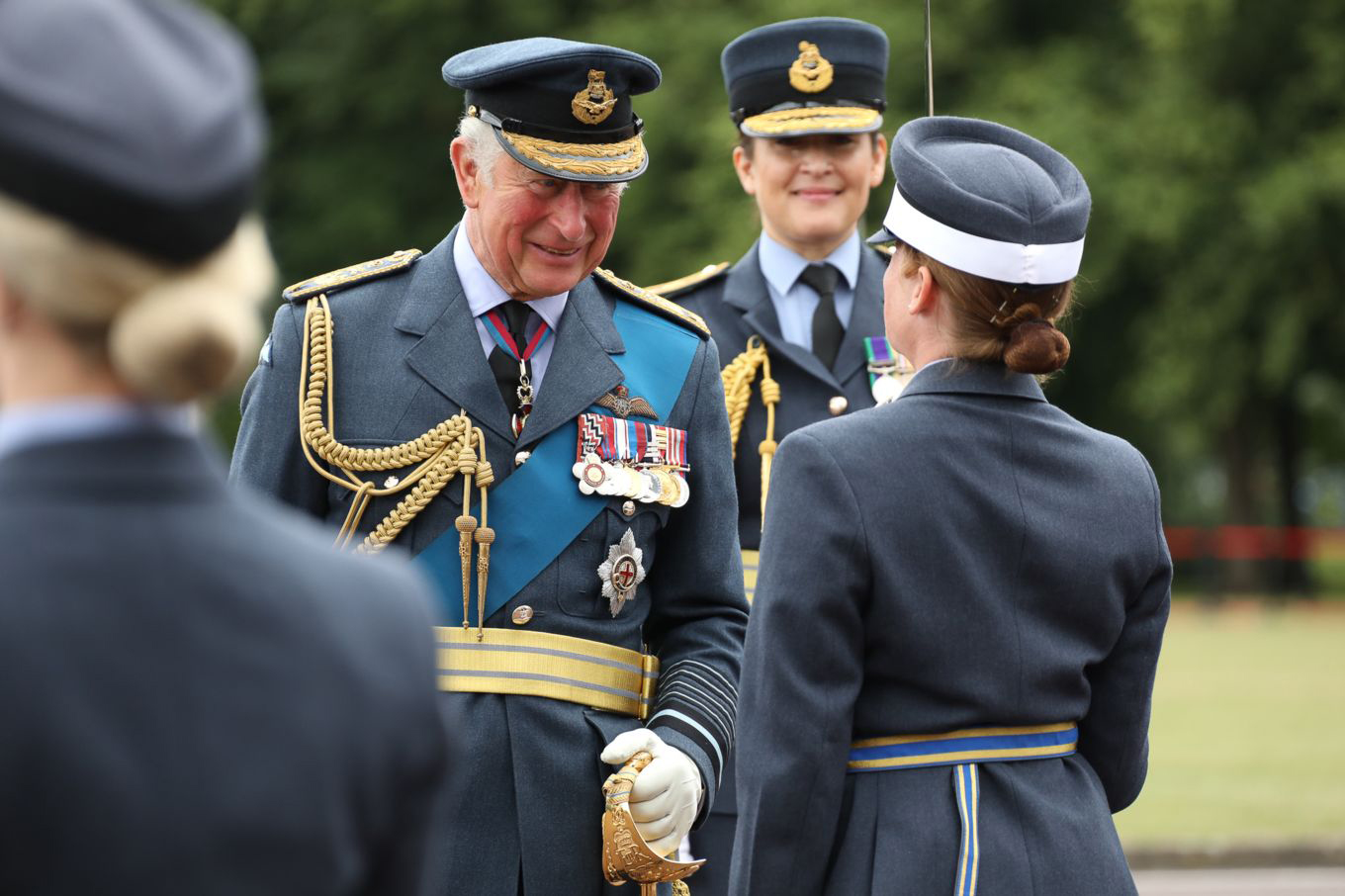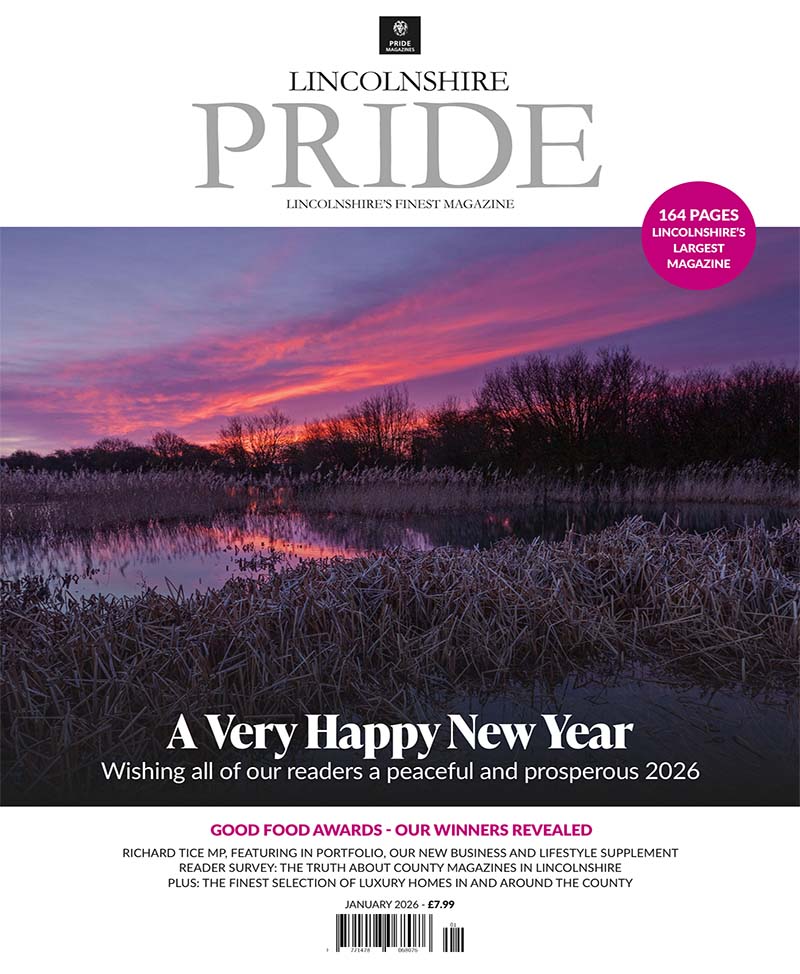
The RAF in Lincolnshire
Since the First World War and the earliest era of air defence, Lincolnshire has always been synonymous with the RAF. But what actually goes on at Cranwell, Coningsby and Waddington? This month we take a deep dive into the world of the RAF as it contributes not just to Britain’s security, but the stability of the rest of the world too…

RAF Waddington
The latest tactical and intelligence aircraft…
Established in 1916 as a Royal Flying Corps Training base, RAF Waddington, is now one of the RAF’s busiest Stations. It is also the hub of UK ISTAR (Intelligence, Surveillance, Target Acquisition and Reconnaissance) and the main operating base for airborne intelligence aircraft and systems.
Air ISTAR is the RAF’s eyes and ears in the sky and provides British and NATO military commanders with critical information about activity on the ground, in the air, and at sea.
The Station is home to the only RAF Remotely Piloted Aircraft Systems (RPAS) Squadron and is excited to be welcoming the Protector RPAS in the near future.
Among the specialist units on Station are the Air & Space Warfare Centre which provides integrated mission support to front line commanders, and the Air Battlespace Training Centre which prepares Service Personnel via demanding and immersive training scenarios across land, sea, and air.
Waddington has a celebrated aviation heritage which dates back to World War One and it was also the first RAF station to host the famous Avro Lancaster.
It is currently undertaking restoration of RAF Waddington’s ‘gate guardian’ an Avro Vulcan B2 which was used during the Falklands War in 1982. The station is also proud to be the home of the Red Arrows, The Royal Air Force Aerobatic Team.
The Lincolnshire community is hugely important to RAF Waddington, and the station says it is very honoured and proud to have taken part in the Freedom of Lincolnshire Parade in April.
“The support that the local community provides is invaluable to RAF Waddington, and we look forward to strengthening our close connections within the Lincolnshire Community in the future.”
Finally, absent since 2021 is the Lincs & Notts Air Ambulance, which used to be based at Waddington prior to moving into its dedicated facilities on Hems Way, just across the A15.
RAF Coningsby
Home to the Eurofighter Typhoon and the BBMF…
Neighbours. Everybody needs good neighbours, so the theme tune goes. And the relationship between RAF Coningsby and its neighbours is something that Station Commander, Group Captain Billy Cooper never takes for granted.
“We ask a lot of our neighbours, and we’re extremely grateful for the support and understanding we receive locally. For example, last year following the illegal Russian invasion of Ukraine, we were taking off extremely early in the morning, as we provided support to NATO enhanced air policing. During that period we received just a single complaint, from a non-local who happened to be visiting the area.”
“We try to engage as much as possible with the community, contributing to life in and around the village as well as the surrounding area.”
RAF Coningsby covers about 1,000 acres and employs 3,500 people in total – about 2,500 employed by the RAF, with the balance comprising of civilians and industry partners like BAE Systems.
The base is home to five squadrons and is crucial in maintaining Britain’s fleet of Eurofighter Typhoon aircraft, of which the country has over 100, each one worth about £100m. The aircraft came into service in 2003 and is designed as a multi-role fast jet, developed alongside partners Germany, Spain and Italy. The aircraft are about 16 metres long, with an 11 metre wingspan and they fly at Mach 1.8 (1,400mph) at an altitude of up to 55,000ft.
Fast jet pilots who have completed their training at RAF Valley on Hawk jets (like the Red Arrows fly, albeit the newer T2 version with its enhanced electronic cockpit displays) will go on to specialise in either the Eurofighter Typhoon or the newer F35 jet. If they specialise in the F35 they’ll be based at RAF Marham, otherwise they’ll complete their Typhoon operational conversion with 29 Squadron at Coningsby.
The base is home to some of the world’s most advanced simulators, operated by partner BAE Systems, which helps to ensure training is cost-effective, low risk and realistic.
The base has two operational squadrons (3 Fighter) and XI (Fighter), as well as 29 Squadron for training and 41 Squadron which tests and evaluates new technologies for the aircraft. The station is also home to 12 Squadron, a joint RAF-Qatari squadron, a reflection of the UK’s interest in maintaining stability in the Middle East.
RAF Coningsby and RAF Lossiemouth in Scotland serve as Britain’s two Quick Reaction Alert stations – covering southern and northern airspace respectively – and responding to investigate potential threats to UK homeland. Coningsby is also the home of the Typhoon Display team (see later in this feature) and is a hub that provides servicing and maintenance of the Typhoon fleet for the whole of the RAF.
RAF College Cranwell
Training the next generation of RAF officers…
For RAF Personnel on their way to becoming commissioned officers, RAF College Cranwell provides training for officers and aircrew, and it has been doing so for over 100 years.
Covering 1,700 acres, RAF College Cranwell was established in 1915 when the Admiralty requisitioned land from the Marquess of Bristol to establish Royal Naval Air Service Training Establishment.
With the amalgamation of the RNAS and RFC (see opposite) in 1918, The Royal Air Force College Cranwell was formed on 1st November 1919 as the RAF (Cadet) College.
Today, RAF Cranwell is home to the RAF College, which provides initial officer training, plus the headquarters of the Central Flying School to train the instructors themselves, and No3 Flying Training School which uses Grob Prefect propeller and Phenom T1 very light jet aircraft to train new pilots.
Also at RAF Cranwell, No6 Flying Training School delivers flying training to university air squadrons, and the station is also home to the Band of the Royal Air Force College.
At the heart of RAF Cranwell is College Hall, a neo-classical hall which replaced a series of rather less impressive naval huts built in the 1920s. The building was officially opened by His Royal Highness the Prince of Wales, late Edward VIII, in October 1934.
Speaking of royalty, King Charles III completed his flying training at RAF Cranwell as a member of Graduate Entry class No 1 in August 1971. The current Prince of Wales graduated from RAF Cranwell in 2008, receiving his wings from his father. King Charles returned to RAF Cranwell in 2020 to conduct the Sovereign’s Review.
The Red Arrows: Flair in the air since 1965…
Smoke On, Go! That’s the command that Red One will give to instruct the pilots in the cockpits of their Hawk T1 aircraft to inject one of three colours of dye into the 400°c exhaust vapour of their Rolls Royce Turbomeca Adour Mk861 turbo fan engine to create the colourful trails of vapour that are the trademark of the RAF’s Red Arrows display team.
Behind the nine display pilots there’s a total of 120 people all working hard to ensure that the team is able to complete about 65 displays each year. Since its formation the squadron has completed over 4,800 displays in 57 countries.
The team begin their lives as fast jet pilots who have accumulated over 1,500 flying hours on aircraft like the Tornado, Harrier or Eurofighter. Usually there are ten applications for each pilot vacancy, and if selected the pilot remains with the team for a three year secondment.
The first five pilots in the squadron’s formation are known as ‘Enid’ (as in, Blyton; as in the Famous Five), whilst the rear formation is known as ‘Hanna’ or ‘Gypo,’ a nickname of one of the team’s earlier members.
The team flies one of three displays depending on conditions; full, rolling or flat. During a display, the team are as close as 30 metres from one another, transiting to their display height of 1,000ft, but flying as low as 300ft. The aircraft themselves are just short of 12 metres long, with a wingspan of 10m. Their maximum speed is 645mph and their single jet engine develops 5,200lbs of thrust.
It’s really important to remember that beyond the pilots themselves, members of the team known as ‘Circus’ are assigned to each pilot, flying them to and from each display, whilst the ‘Blues,’ from which members of Circus are selected, are the support team responsible
for mechanical, avionics, survival equipment and other technical specialisms, plus PR, photography and logistics. The Red Arrows were formed in 1964 as an amalgamation of the Red Pelicans, Black Arrows giving the team their new and enduring identity.
The Battle of Britain Memorial Flight
Marking the 80th Anniversary of The Dambusters’ Operation Chastise…
It’s Tuesday 16th May, and the team at The RAF’s Battle of Britain Memorial Flight are climbing into the cockpit of their Avro Lancaster PA474 in preparation for a flight to mark the 80th anniversary of the Dambusters raid, Operation Chastise. The Lancaster crew a special route over all of the major Bomber Command bases, beginning over RAF Spitalgate (since 1975 the British Army’s Prince William of Gloucester Barracks) at 6.58pm and reaching RAF Coningsby at 8.07pm.
The heritage flight was established in July 1957 at RAF Biggin Hill and relocated to Coningsby in 1976. The Flight operates six Spitfires, two Hurricanes, a Lancaster, a C47 Dakota, and two Chipmunk aircraft (these are primarily used for training). The aircraft are flown by regular RAF Aircrew and aircraft can be regularly seen in the skies over the UK from May to September each year. They are flown to celebrate and commemorate public and military events from State occasions such as Trooping the Colour to major airshows and flypasts for public events.
Quite aside from the pilots, much of the maintenance of the aircraft takes place at the heritage flight’s Coningsby headquarters, with a team of 39 engineers who are highly specialised in ensuring the continuing airworthiness of the priceless machines.
The adjacent Battle of Britain Memorial Flight Visitor Centre is operated by Lincolnshire County Council and is open Mon-Fri, 10am-4pm.
Typhoon Display Team
Demonstrating the Eurofighter’s capabilities…
Undoubtedly the Eurofighter Typhoon is one of the most sophisticated aircraft on the planet and is currently the backbone of the RAF’s fast jet fleet. There’s also a dedicated display pilot and aircraft based at RAF Coningsby to show off the aircraft’s capability at both national and international air displays.
29 Squadron is based at Coningsby and is responsible for the training and operational conversion of pilots. One of its instructors is also chosen to fly the Typhoon in displays, and currently that pilot is Flight Lieutenant Matt Brighty. He’s assisted by a management, engineering and PR team, as well as ground support, with a dedicated Typhoon nicknamed Blackjack, with its distinctive black livery.
“It is the realisation of a boyhood dream to be given the opportunity to showcase the Eurofighter Typhoon for the Royal Air Force. Being selected as the display pilot for this year’s season is an honour and I count myself very lucky to be in this position,” says Flight Lieutenant Matt Brighty.
See Matt and the Typhoon in action at the North East Lincolnshire Armed Forces Weekend, Cleethorpes, 17th and 18th June.
BBMF visitor centre at RAF Coningsby…
A rare opportunity to get up close and personal with heritage aircraft…
Having Opened in April 1996, the Battle of Britain Memorial Flight Visitor Centre is run by Lincolnshire County Council, rather than the flight itself, but the two work closely with one another welcoming over 32,000 into the centre and into the BBMF hangar every year.
Entry is by guided tour only, which means visitors benefit from a knowledgeable tour guide who can provide visitors with details of the individual aircraft histories and tell inspirational stories of the men and women who operated these types of aircraft during World War Two.
The adjacent hangar houses the Lancaster PA474, Douglas Dakota ZA 947, six Spitfires, two Hurricanes and two Chipmunk aircraft, which are maintained by the team on site. Please be aware that sometimes the aircraft will not be present due to maintenance or displays.
Find Out More: Battle of Britain Memorial Flight visitor centre, Dogdyke Road, Coningsby, Lincoln LN4 4SY, call 01522 782040, see www.visitlincolnshire.com, open Monday – Friday, 10am to 5pm.
International Bomber Command Centre
Based At Canwick and created in 2018, the International Bomber Command Centre was created for the 100th anniversary celebrations of the RAF and it remembers the 57,861 who gave their lives as part of air operations during WWII. A memorial spire features the names of everyone lost and the centre has created a searchable digital archive of photographs, letters and experiences.
Find Out More: The IBCC is open from Tuesday to Sunday 9.30am – 5.00pm on Canwick Avenue, Lincoln LN4 2HQ. See www.internationalbcc.co.uk.
Ride in a Lancaster
Lincolnshire’s Aviation Heritage Centre is the only place in the world you can enjoy a ride in a Lancaster. The team’s ‘Just Jane’ Lancaster NX611 is the star attraction of the centre, set up by the Panton Brothers in 1989 in memory of their brother.
Find Out More: East Kirkby, PE23 4DE. 01790 763207 or see lincsaviation.co.uk.
Aviation Heritage in Cranwell
Cranwell’s Aviation Heritage Museum portrays the fascinating story of this historic establishment from its early days as a Royal Naval Air Service base to the current day. The experience includes interactive exhibits including a Jet Provost flight simulator, Vampire T11 Cockpit, exhibitions and artefacts. There is also a courtyard area with a Jet Provost aircraft.
Find Out More: Open Friday – Monday, 10am – 3pm, see www.heartoflincs.com.






